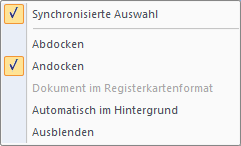A navigator similar to Windows Explorer is displayed on the left side of the work window. To display or hide the Project Navigator, use the View → Navigator menu option or the corresponding toolbar button.
The navigator shows the model data of opened files in a tree structure. Use [+] to expand the branches of the tree and [-] to collapse them again. You can also double-click the entry.
The navigator is similar to a toolbar: You can use the mouse to "grab" the navigator in its title bar and move it to the workspace. To dock it, double-click the title bar or move the navigator to the window frame. During the move, the buttons shown on the left are displayed, which make it easier to dock to one of the four edges: Drag the navigator to the desired button and release the mouse button as soon as the mouse pointer is over the button.
If you do not want the navigator to be docked to the window frame, clear the corresponding selection in the shortcut menu of the navigator.
If the Synchronized Selection is active, an object marked in the navigator is also highlighted in color in the model graphic.
The shortcut menu option "Automatically in background" allows for the minimization of a docked navigator: As soon as the work window is activated with a mouse click, the navigator moves to the edge as a narrow bar (see Figure 3.9). This feature can also be selected via the pin at the top right of the navigator (see Figure 3.10).
The navigator opens in full size when you move the pointer across the Project Navigator field highlighted in the docked navigator bar.

